CREATIVITY & PROFESSIONAL SUCCESS
FOR INDEPENDENT MUSICIANS
Part Two: What Does the Future Hold?
By Jack Gold-Molina
(August 2018)
One of the most difficult problems to address is determining and understanding what the future holds for artists/musicians who are working as creative professionals. The music industry has changed dramatically over a very short period of time. Prior to 2006, CD sales were an important source of income until their significant, steady decline. Digital downloads increased for a few years after that, then digital streaming became the primary method for consumers to listen to music. Artists and musicians are paid almost nothing for streaming, on average $.004 per song. Likewise, consumers often choose to listen to albums or individual songs through inexpensive subscription streaming services like YouTube or Spotify rather than purchasing CD's that artists/musicians are paid substantially more for in royalties.
The shift in the music industry to digital streaming is complex. In looking at overall industry statistics, it appears as though the music business is booming. The chart below illustrates the decline of physical media sales since 1999, as they have been increasingly replaced by digital sales since 2004.
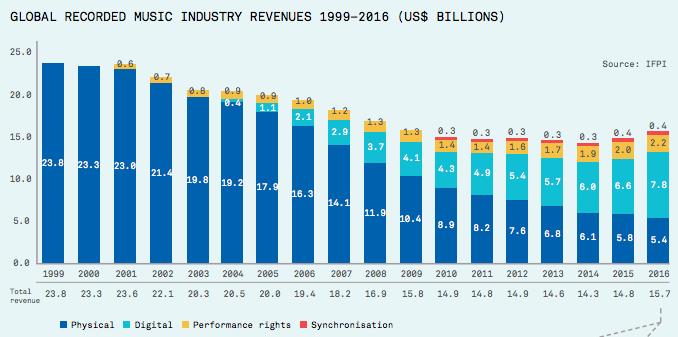
While the majority of music is purchased digitally online, sales of LP's have risen since 2005. They continue to do so, although not to anywhere near the levels that they were at prior to 1982 when compact discs were first introduced to the general public in Japan by Sony Corporation. The reasons for the recent increase in LP sales include superior sound quality to digital music streaming and downloads, high quality and collectible album art, and an attempt to capture the listening experience of decades past. According to a market research poll by ICM Unlimited, music and video streaming is now driving vinyl sales. Nick Atkins, writing for Music Week, stated that 45 percent of vinyl buyers surveyed had heard an album via streaming on YouTube, Spotify, Soundcloud or another service, then purchased a vinyl copy.
According to Atkins, "Much of this streaming is free, suggesting that music heard for free is encouraging sales of physical records. These findings could partially be explained by the trends for collecting vinyl records as a hobby and for the artwork, with 50 percent of vinyl buyers describing themselves as vinyl 'collectors.'" Mark Savage, reporting for BBC News, wrote that it gives people an "old-school vibe," and that buyers like to support artists financially if they can, particularly if they put an effort into making a release look special. The chart below illustrates recorded music revenues in the United States by format from 1980 to 2015.
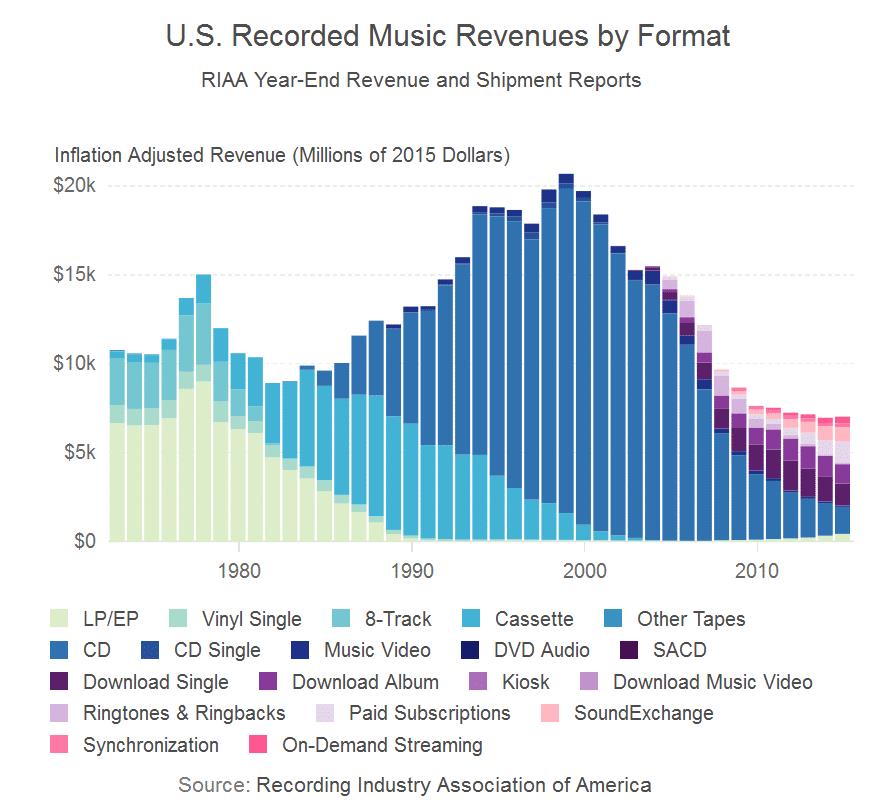
Jonathan Taplin, former tour manager for Bob Dylan and The Band and film producer for Martin Scorsese, Wim Wenders, and Gus Van Sant, wrote in his book Move Fast and Break Things that 400 hours of video are uploaded to YouTube every minute of every day. Despite stories promoted on Google and on television about YouTube videos going viral and creating social media millionaires, most of them have less than 150 views. While it has also become the world's dominant audio streaming platform, due to rampant piracy on its site, it pays artists and record companies less than a dollar per year for every user of recorded music. With artists being paid an average of $.004 per track, they make approximately $400 for 100,000 plays. In 2015, vinyl record sales generated more income for creators of music than the billions of music streams on YouTube and other ad-supported services such as Spotify.
Given the massive global reach available at very little cost, digital music streaming is, however, often used with great success when incorporated into an artist's marketing plan despite the lack of immediate financial return. The table below illustrates some of the positive and negative aspects of using streaming services professionally.
| Positive Aspects of Streaming | Negative Aspects of Streaming |
| Worldwide marketing/promotion at little or no cost | Extremely low royalty rates paid to artists |
| Increased international listenership and presence | Music in physical and digital form is often stolen by distributors and streaming companies. Digital theft is difficult to track and reconcile. |
| Increased international recognition | Undermines radio play |
| Increased attendance at live shows | Undermines CD/LP/download sales |
| Helps build/grow international network | Artists can wind up owing record companies for sales lost due to streaming |
Punk singer and author Henry Rollins provides an optimistic and supportive view about the future of vinyl. "The appreciation of vinyl is a thing because, before CDs, you really didn't have media by which to compare," he said, in a recent interview for the Discogs Marketplace blog. "You had records and tapes and that's how recorded music sounded. After 30 plus years of digital music, streamed music and whatever other digital source, listeners now have the opportunity to have that 'wow' moment when they hear vinyl through good playback and are able to determine, with no doubt, that vinyl sounds much, much better than a CD or something blaring out of your phone. Every house and apartment should have record players in them. Things would be better."
Merchandise sales have long been a smaller part of a professional musician's income than performing. The Beatles recognized that, even though they were at the top of the international pop and rock charts, during their touring years from 1960-1966 performing was where most of their income came from. Although their royalty contracts weren't particularly lucrative at that time, they were playing to increasingly large crowds. Whether they wanted to or not, because they were in such demand worldwide, they finally had to play large stadiums in order to keep fans from rioting. Despite the large amount of money that they were making, the difficulties that this kind of chaos created for the band is what ultimately resulted in their decision in 1966 to stop performing live.
Full-time independent musicians are faced with the inter-related challenges of having to make money to support themselves and raise their profiles. Sometimes, this means constantly being on the road just to make a living. Touring presents its own issues, as Mario Rubalcaba, California A-list punk drummer for the bands OFF!, Rocket from the Crypt, Hot Snakes and Earthless illustrates. "Some obstacles as an artist are relying on backline rental gear. Sometimes they don't have great gear or it is totally the wrong gear. Luckily, I am in bands that don't have crazy instrumentation, but still playing on broken or malfunctioning gear can really take the spirit out of the music. You've got to just do your best. My first real interaction with festivals was probably with Rocket from the Crypt. Through this band I have played many different types of festivals and still continue to play many to this day. I quite enjoy them. Some are more organized than others and as an artist, some treat bands better than others and some are pretty shabby at times, but overall they are somewhat consistent. As long as they are organized, have great gear and food, a place to hang out that isn't filthy, then I'm okay just about anywhere."
"Performing in Europe is vital for us. It is where we make most of our income," explains New York based creative jazz reeds player Ingrid Laubrock. "For me as a European, I also love going back. The audience is often informed and listens deeply. Travel and jet lag can be huge obstacles. It's hard to sit in planes or trains for days on end and then just get up and perform. You get used to it, but it can be draining. What I find difficult at festivals is that there often is just a line check and not time to get the sound you want. But you have to trust that the sound people are experienced and will figure it out quickly. As you get older and more experienced, you manage to not be too distracted by any obstacle and just play through them."
"The band I was in, Witch Mountain, booked a couple tours over there," said Portland rock vocalist Uta Plotkin, describing the distances that she covered in Europe before she retired from performing full-time. "The doom metal scene was welcoming to us and of course there are many more opportunities to play festivals in Europe and the UK than in the US. I gathered that festivals are a pretty standard part of European touring during certain times of year. It can be an opportunity to play to a much larger audience than normal, because so many people are there who are generally into the specific genre of music that the festival is promoting. We often were only at a festival for the day we played but there's so much going on in the festival microcosm that you can do and see a lot more in a short period of time."
"Festivals are big and chaotic which makes all the logistics more difficult," Plotkin continued. "Traffic, parking, load-in are all more stressful. I had some health issues when we played Hellfest, and the heat, crowd and long distances between everything wasn't ideal. Some festivals are not well attended and playing for a small crowd can be demoralizing. But these are all little pieces of being a touring musician and you take them in stride because you have to. You don't have much of a choice."
"Gaining adequate publicity is another perennial challenge and comes down to a number of factors that may be unique to the given location, such as the popularity of the musical genre in question, competing events in the same time frame, the presence or lack of allies within the local press, and so on," explains Seattle based progressive rock and experimental music guitarist Dennis Rea. "One has to weigh the probability or improbability of a large turnout against the sometimes prohibitive expense of buying advertising. Without bringing in sufficient income at the door, one can't afford to pay better-known acts, yet without more recognizable names on the bill, one can't realistically expect to expand the audience. It's far easier to interact with the audience and musicians when you're not penned up in a vast stockade with an intimidating security presence, not to mention a high tariff. Sound quality and visibility are typically superior at the smaller events as well. And it's simply not possible to mount a massive spectacle without making a devil's bargain with corporate entities who represent the antithesis of what the music – at least the music that I care for deeply – is all about."
Musical empathy has been defined in the research as "modulating musical perception – 'feeling into' a piece of art," according to neuroscientist Marco Iacoboni, writing for the journal Frontiers of Neuroscience. Music triggers "the same complex social processes in the brain that are at play in human social interactions." From a listener's perspective, this kind of empathy may be more profound when identifying with an artist as a person with respect to "an emotional response that stems from another's emotional state or condition," a reaction to the trauma of an artist who had bouts of severe depression, for example. From an actual musician's perspective, however, musical empathy is how one feels and interprets another player's musical notes, tonal inflections and phrasing particularly during spontaneous free-form improvisation. It can also reflect an artist's feelings of compassion toward his or her listeners.
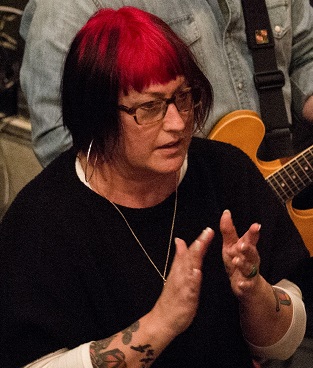
Carrie Akre with Goodness 2017
"I really feel like music is a healing form," explained Carrie Akre, lead vocalist for veteran Seattle grunge bands Goodness, Hammerbox and The Rockfords. "Music heals people, it sustains them through the good and the bad. Music has been a part of their lives and events that have happened to them. Several people have said to me, 'This got me through something like an antidote. I needed this like medicine.' That's powerful. I find that very profound. That is almost the highest compliment to say, 'You made something that affected me.'"
"I think the name of the game is getting your stuff to people, whatever they do with it," Akre continued. "I would rather reach people who say, 'Oh, I liked it!' That is even a challenge because there is so much stuff out there. Then again, I wouldn't bog down or try and hold on or control anything because I think that is futile. Creatively, the practice of staying open to see what comes out of you is a good thing to do as an artist, as opposed to getting stuck in a rut. In Goodness, I think there are very distinctly some highly talented people with their own visions and their own abilities. That is like having all of that to tap into. I don't know if we do that very well within Goodness, but I definitely think that about everyone."
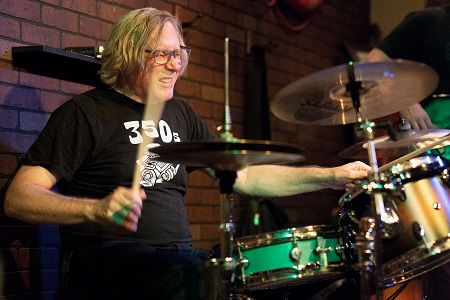
Steve Smith 2017
When his students begin to question their learning and show signs of complacency, Steve Smith of the Seattle Drum School of Music tells them a story about developing understanding. "This is the story about the Zen master and his student. A Zen master is standing outside and his student comes. The Zen master says, 'Welcome to your first lesson. For today's lesson, I want you to go inside this hut. Inside the hut you will find a rock. I want you to go inside and study the rock, come back out and tell me everything you know of the rock.' So, the student goes in and comes back out 10 seconds later: 'It's a rock, it's round, it's grey.' 'Very well,' said the Zen master. 'You have done well. Come back tomorrow for your next lesson.' "He comes back the next day. 'Welcome,' says the Zen master. 'For today's lesson I want you to go inside the hut. Inside the hut you will find a rock. I want you to study the rock, come back out and tell me everything you know.' So, he is in there for like five minutes and he comes out and says, 'It's a rock, it's round, it's got a crease on one side, it's coarse on the other side, it's got a little bit of mold, a little bit of this and that, it's got a chip on the very bottom, and so on, and so on.' This goes on for six months. "He comes back six months later for his lesson and the Zen master says, 'Welcome. For today's lesson, I want you to go inside the hut. Inside the hut, you will find a rock. I want you to go in and study the rock, come back out and tell me everything you know.' He was in there for eight hours. He comes out and he talks about this rock for an hour and a half. The lesson is: if you want to understand your world, learn to understand one thing and understand it completely.
"So, I tell them that story and I'll have them sing this and play that, and sing it to where they develop so much more deeply than they ever thought. They had no idea what that rhythm was until that point. They slow it down, they break it down to where at the end of the lesson there is no comparison. And then they come back next week, and they have that awareness. Their perception has been magnified, and their attention to detail has been cultivated."
The act of creating art and music can be deeply healing emotionally and spiritually, and it is a common reaction to societal issues when people feel as though they have little control and are being treated unjustly or unfairly. "I enjoy what I do, being able to share an experience with band and crowd and to expose as many folk to the talent I am privileged to play with," said synth player The Other One, who is a stalwart of the UK festival scene and performs, records and tours with space rock and psychedelic bands Red Elektra 69, vert:x, and Nik Turner's Space Ritual. "I am living in a dream, music is part of it, occasionally a nightmare. I am unable to work, same with music, it's complicated. As seen from the perspective of a guy that has to deidentify to be allowed the freedom of playing music without persecution, if the 'them' had their way, I would be in the salt mines for stealing my national insurance that has been paid all my working life. Not very inspiring, just a brief bit from another angle."
"I mostly stick to the original wonder, focus and try and serve the muse," concurred Vince Cory, established UK guitarist and bandmate of The Other One's in Red Elektra 69 and vert:x. "I try and be as honest to the sound as possible, to create an up-sound for healing broken vision. It's England – art at our level is not art by their so-called standards. We are low class criminals in their eyes. We just play to serve the muse and give thanks for what we have heard on the way, and hopefully help it all along until we drop and someone else picks up the threads we left and runs with them. I come from low-level working class origins. I worked from age 16 straight from school. School sucked except for LPs we heard and leant each other. Had a local band since 1980 and have played ever since locally and then ended up."
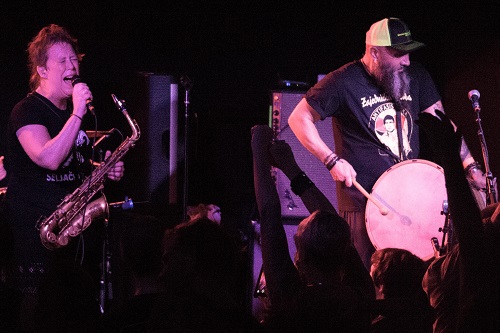
Amy Denio and Gino Yevdjevich with Kultur Shock
"I am determined to follow my artistic vision, no matter what," explained Seattle reeds player and multi-instrumentalist Amy Denio. "This means to stay playfully creative, to learn by collaborating with other musicians and artists, to keep growing as an artist and point myself toward new horizons. Music creates community by bringing strangers together to share a common experience."
When asked about her creative and professional strategy, Denio said, "To collaborate with as wide a variety of musicians and artists as possible. That way I keep learning, and my own boundaries of experience and expression are challenged. It is very difficult to be a self-employed independent musician because I must work constantly to find work, do the work, present my work, etc. But I persevere and am very lucky to insist on following my natural inclination to be a musician."
"I teach in several music schools," Denio continued. "I transcribe music for singer/songwriters who don't know how to write music. I run my own record label and publishing company. I play in several bands which tour internationally. I just received a grant to compose for 17-piece chamber orchestra and am thrilled with my new compositions. I had been touring incessantly, which made it difficult to find work when I was home. Now I am taking a major break from touring and am re-entering the local creative scene in Seattle. I was living in growing catastrophic debt for many years."
According to retired U.S. Army General, Yale University fellow and business strategy advisor Stanley McChrystal in his book Team of Teams, much like a Silicon Valley garage startup that rides an idea or product that is well-timed, rather than uniquely brilliant, to an absurd level of wealth, understanding and adapting to 21st century factors such as complexity and continual change has become an imperative and is no longer optional. It will be what differentiates success from failure in the years ahead. Creative success depends on an artist/musician's ability to adapt in the rapidly and continuously changing environment of the entertainment business, and society at large.
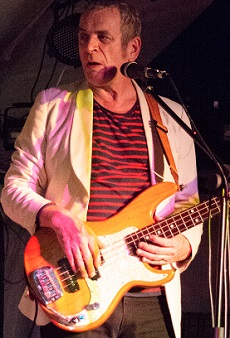
Keith Bailey with Here & Now at Kozfest 2017
"My feeling is this," said bassist Keith Bailey, who is a founding member of the iconic UK psychedelic bands Here & Now and Planet Gong. "If you think of yourself as working within the music 'industry' – a term which I personally find repugnant, and a contradiction in terms – then you are just that, a worker in an industry. You will measure yourself by all those material criteria that any industry sets as the parameters of success: by how many units you shift, and how much money you make, etc. etc. But if you feel yourself to be an artist, then you need to define what your art is and what it's for. My own feeling is that the function of art is to define new forms – new ways of thinking, living, and even just being – that can influence others on many levels and can inspire people to either change their outlook, or how they work, or even how they see the world."
"By that measure, I think I'm moderately successful, creative and professional in the way I work," Bailey continued. "You see, I think if your art is to be successful, then you must personally have a real reason to do it. My mission is now, and has always been, to try to influence people to think for themselves, to evolve their own unique way of operating within a world that increasingly seems to value the homogenization of both individuals and art forms in a way that always seems to result in a dumbing down of the culture, and turns people ever more into units to serve the vast wheels of an industrial juggernaut that has neither brakes, understanding of the effects it has, or compassion for the trials and tribulations of ordinary people. My vision is of a world that no longer sets material gain as the parameter which defines success, but rather appreciates and values people for what they are and can do – both of which can be quite wonderful in many ways and on many levels. I work intuitively and am guided by what I might call inner promptings and inspiration, whether in writing new material or setting usually attainable goals for whichever band I happen to find myself in. I do feel that creativity is more fluid and productive when you don't have to worry about where the next meal is coming from, whether because you have no money at all to worry about as such, or you have patronage, or are extremely lucky."
Alto saxophonist, painter and writer Wally Shoup, in his book Music as Adventure, examines what constitutes a con versus honest activity. According to Shoup, the net effect of years of being bombarded by advertising and veiled threats that "if you're not a winner (by rules the winners have established) then you have to be a loser," is that no one feels totally secure with themselves. This worldview fosters anxieties and fears that can only be alleviated by continuing to play this game that no one is protected from whether they want out or not.
There is such a thing as honest activity, however, and it can be found in the correct practice of free improvisation. It is a way to access one's individuality that lies beneath the constructed surface self that is primarily shaped by values associated with winning the predominant societal game. In its purest form, it consciously disavows the value of money and prestige and it can help in rediscovering the voice of one's truest self.
"What I strive for in music is the accumulation of 'quality experiences,' situations that are enriching and memorable," Shoup said in a recent interview. "These could occur in public performances or in private sessions. Quality, in this sense, is subjective, hard to measure. My quality experience might not be yours, but hopefully it's shared. And over time these build up, and one grows as a player and as a human being."
"What matters is that the playing stays open and free, that creativity and individuality are the 'coin of the realm,' and that a positive spirit reigns," Shoup continues. "I realized from the beginning that this music was not about money or fame. It was about playing unfettered music with kindred souls, being open to the moment, and always working to become a better musician. To the degree that I've stayed true to those ideals is a good measure of my own success."
"If the playing is the primary need and desire, I think the 'real world' aspects: survival, recognition, respect, opportunity and, possibly, security will take care of themselves," he said. "Just as one has to take each improvisation for what it is – and not for what it isn't, one needs to accept the fruits of playing for what they happen to be. Hopefully, the rewards are numerous and sufficient. For me, the playing has put me in the middle of a wide range of 'quality experiences,' and for that, I feel grateful and fulfilled."
Sources
Atkins, N. (2016). Streaming drives vinyl sales – report. Music Week. Retrieved from: http://www.musicweek.com/news/read/streaming-drives-vinyl-sales-report/064544
Carducci, J. (1995). Rock and the Pop Narcotic: Testament for the Electric Church. 2.13.61, Inc.: Los Angeles, CA.
Cleopatra Entertainment/Cleopatra Records, Inc. (2017). www.CleopatraRecords.com
Discogs (2018). The Future of Vinyl: Henry Rollins. Discogs Blog. Retrieved from: https://blog.discogs.com/en/future-of-vinyl/?utm_source=social&utm_medium=twitter&utm_campaign=Culture_2018_01_29
Howard, R. (2016). The Beatles: Eight Days a Week – The Touring Years. Apple Corps, Ltd: London; Imagine Entertainment: Beverly Hills; White Horse Pictures: Los Angeles.
Johnson, J.N. (2017). Growing Music Revenues, Where To Invest Your Time In 2017 And Beyond. Smart Band Management. https://smartbandmanagement.com/growing-music-revenues-where-to-invest-your-time-in-2017-and-beyond
McChrystal, S. (2015). Team of Teams: New Rules of Engagement for a Complex World. Penguin Publishing Group/Random House: New York, NY.
Molina, J. (2016). Interview with Ingrid Laubrock.
Molina, J. (2016). Interview with Uta Plotkin.
Molina, J. (2016). Interview with Dennis Rea.
Molina, J. (2016). Interview with Mario Rubalcaba.
Molina, J. (2017). Interview with Keith Bailey.
Molina, J. (2017). Interview with Amy Denio.
Molina, J. (2017). Interview with members of Goodness: Carrie Akre, Chris Friel, Fiia McGann, Danny Newcomb and Garth Reeves.
Molina, J. (2017). Interview with Craig High.
Molina, J. (2017). Interview with Dennis Rea.
Molina, J. (2017). Interview with Wally Shoup.
Molina, J. (2017). Interview with Steve and Kristy Smith.
Molina, J. (2018). Interview with Vince Cory.
Molina, J. (2018) Interview with The Other One.
Savage, M. (2016). Music streaming boosts sales of vinyl. BBC News. Retrieved from: http://www.bbc.com/news/entertainment-arts-36027867
Sisario, B. & Russell, K. (2016). In Shift to Streaming, Music Business Has Lost Billions. New York Times. Retrieved from: https://www.nytimes.com/2016/03/25/business/media/music-sales-remain-steady-but-lucrative-cd-sales-decline.html
Shoup, W. (2011). Music as Adventure. Nine Muses Books: Winston, Oregon.
Taplin, J. (2017). Napster, Spotify and the Fall of the 'Middle-Class Musician.' Rolling Stone. Retrieved from: https://www.rollingstone.com/culture/move-fast-and-break-things-book-excerpt-w480401
Wallmark, Z., Deblieck, C. & Iacoboni, M. (2018). Neurophysiological Effects of Trait Empathy in Music Listening. Frontiers of Behavioral Neuroscience. Retrieved from: https://www.frontiersin.org/articles/10.3389/fnbeh.2018.00066/full